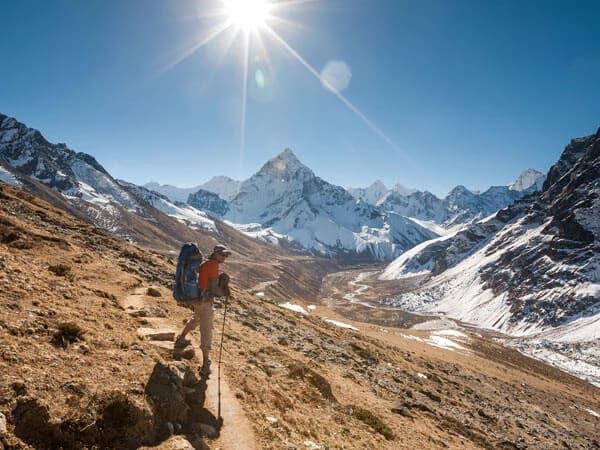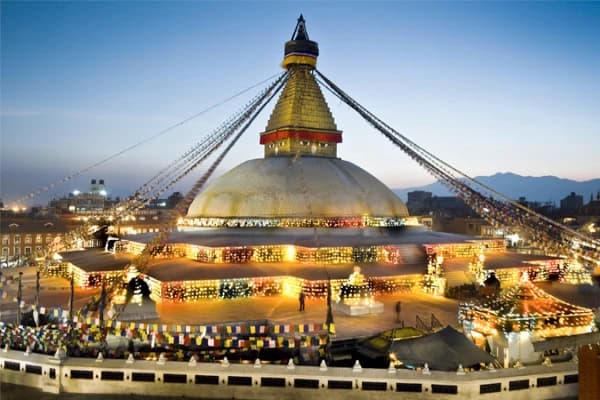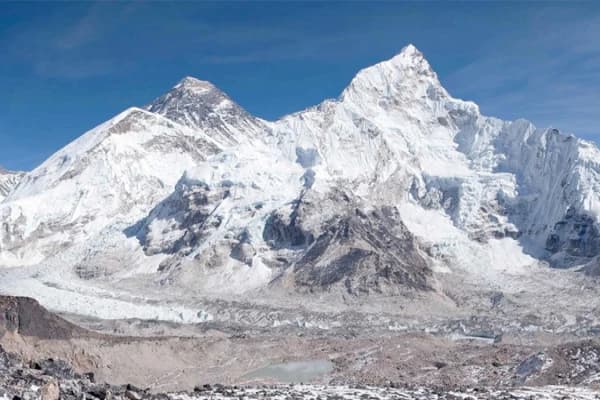The Everest Base Camp (EBC) trek is one of the most iconic trekking experiences in the world, attracting thousands of adventurers every year. Among the best months to undertake this journey, October stands out for its favourable weather, clear skies, and stunning views. This comprehensive guide will give you everything you need to know about the Everest Base Camp trek in October, from planning and preparation to understanding the weather and challenges you might face.
Planning Your Everest Base Camp Trek in October
Understanding the Route
The Everest Base Camp trek follows a well-established route through the Khumbu region, starting from the town of Lukla and winding through a series of Sherpa villages, dense forests, and high-altitude passes. In October, the route is particularly scenic, with vibrant autumn colours and stunning views of the Himalayas. The trek typically takes 12-14 days and covers approximately 130 kilometres (80 miles) round trip.
The route of Everest Base Camp Trek includes:
- From Lukla to Phakding (2,610m/8,561ft).
- Trek from Phakding to Namche Bazaar (3,440m/11,284ft)
- Trek from Namche to Tengboche (3,860m/12,661ft)
- Trek from Tengboche to Dingboche (4,410m/14,465ft)
- Trek from Dingboche to Lobuche (4,910m/16,105ft)
- Trek from Lobuche to Gorak Shep (5,140m/16,860ft)
- Hike to Kala Patthar (5550m/18,204ft) and descend to Pheriche (4,240m/13,908ft)
- Trek from Pheriche to Namche (3,440m/11,284ft)
- Trek from Namche to Lukla (2,840m/9,316ft)
Physical Preparation
Everest Base Camp Trek is a moderately challenging trek with high altitude and rugged terrain. You must be physically fit and prepared to hike 6-7 hours daily. The days are mild in October, but the nights can be chilly, so training should include cardiovascular and strength exercises. Focus on building stamina with long hikes and include uphill walking in your routine. Carrying a loaded backpack and prior trekking experiences are also essential to simulate the trekking conditions.
Booking and Permits
October is one of the peak trekking seasons, so booking your trip well in advance is advisable. You will need three main permits:
- TIMS (Trekkers' Information Management System) Card: This card is required for all trekkers. It helps manage trekking activities and ensures safety.
- Sagarmatha National Park Entry Permit: This permit is needed to enter Sagarmatha National Park, where Everest Base Camp is located.
- Khumbu Pasang Lhamu Rural Municipality Permit: This local permit is required for trekking in the Khumbu region and supports regional development projects. It cannot be issued in Kathmandu; it must be obtained in Lukla or Monjo, with a fee of NPR 2000.
You can obtain these permits at the Nepal Tourism Board in Kamaladi, Kathmandu.
Weather and Climate in October
Temperature in October at Everest Base Camp
October brings stable weather conditions to the Everest region. During the day, temperatures at lower altitudes range from 10°C to 15°C (50°F to 59°F), making for pleasant trekking conditions. As you ascend towards the base camp, temperatures drop significantly, especially at night, where they can plummet to -10°C to -15°C (14°F to 5°F). Proper layering is critical to staying comfortable.
For those interested in trekking slightly earlier, the EBC trek in September offers different weather patterns that you can review.
Recommended Read:
How Cold is Mount Everest
The Best Time to Trek to Everest Base Camp
October is the best time to trek on the Everest Base Camp. The clear weather provides spectacular views of Everest and other towering peaks. The post-monsoon season means less rainfall, and the trails are dry and safe. Moreover, the cool temperatures reduce the risk of heat exhaustion, which can be a concern during warmer months.
The Wildlife and Vegetation of the Everest Region During October
In October, the Everest region is alive with colour. The lower altitudes are adorned with rhododendrons and pine forests, their vibrant autumn hues enhancing the landscape. This season also provides excellent opportunities for spotting wildlife in the Everest Base Camp area, including Himalayan tahrs, musk deer, and various bird species, such as the beautiful Danphe, Nepal’s national bird. The clear skies and fresh air further enhance the experience, making wildlife viewing more enjoyable and frequent.
Pros and Cons of Everest Base Camp Trek in October
Pros
Clear Weather: October offers the clearest skies of the year, providing breathtaking views of the mountains.
Moderate Temperatures: Moderate daytime temperatures make for pleasant trekking.
Vibrant Scenery: Autumn colours and thriving wildlife appeal to the trek.
Cultural Experience: October coincides with significant festivals like Dashain and Tihar, providing cultural immersion opportunities.
Cons
Crowds: During peak season, the trails, teahouses, and base camp can be crowded.
Higher Costs: Due to the increased demand, prices for accommodations and flights to Lukla are typically higher.
Shortage of Accommodations: Popular teahouses may be fully booked, requiring early reservations.
Difficulties During The Everest Base Camp Trek in October
Altitude Sickness
Altitude sickness is a common challenge on the Everest Base Camp trek, regardless of the time of year. The risk begins at around 2,500 meters (8,200 feet) and increases as you ascend. The mild weather doesn't reduce this risk in October, so proper acclimatization is essential. Plan for acclimatisation days in Namche Bazaar and Dingboche to help your body adjust. Be aware of symptoms like headaches, dizziness, and nausea, and descend if symptoms worsen.
Difficulty in the Trekking Route
The trek to Everest Base Camp is challenging, with steep ascents, rocky trails, and high altitudes. While the clear weather in October makes the trek safer, the physical demands remain significant. You should be prepared for difficulties in Everest Base Camp trekking, including long days of hiking, sometimes extending up to 8 hours, with considerable elevation gains. Trekking poles, high-quality boots, and a good fitness level are essential to effectively manage the route's difficulty.
Accommodation Issues
Due to the arrival of trekkers in October, finding accommodation can be challenging. Teahouses can be fully booked along the route, especially in popular stops like Namche Bazaar and Gorak Shep. It's advisable to book in advance or trek with a guide who can secure accommodations for you. Be prepared for basic comforts; the higher you go, the more limited the facilities become.
Crowds and Cost
October is one of the busiest months on the Everest Base Camp trail. The increased number of trekkers can lead to crowded trails, busier teahouses, and a less tranquil experience. Additionally, the demand pushes up the cost of flights, accommodations, and guides. Budget accordingly, and consider travelling in a small group to minimise the impact of the crowds.
Physical Challenge
The physical challenge of the Everest Base Camp trek in October should not be underestimated. The combination of altitude, long trekking days, and fluctuating temperatures requires high endurance and mental resilience. Advanced training, a steady pace, and staying hydrated are vital to overcoming these challenges.
Festivals in Nepal in October
October is a festive month in Nepal, with significant celebrations like Dashain and Tihar. Dashain, Nepal’s biggest festival, celebrates the victory of good over evil and is marked by family gatherings, feasts, and rituals. Tihar, the festival of lights, honours different animals, including crows, dogs, and cows, and culminates in a day of reverence for brothers and sisters. Trekking during this time offers a unique cultural experience, with opportunities to witness these festivals in the villages along the trail.
How Is Everest Trek Accommodation in October
Accommodations during the Everest Base Camp trek range from basic teahouses to more comfortable lodges in the larger villages. Due to the high number of trekkers in October, booking your accommodations well in advance is advisable. The teahouses offer simple rooms, usually with twin beds and shared bathrooms. Some teahouses may provide hot showers and limited Wi-Fi for an additional fee.
Hiring Porters and Guides
Hiring a porter and guide can significantly enhance your trekking experience. A guide can provide valuable insights into the culture, landscape, and safety, while a porter can carry your heavy gear, allowing you to trek more comfortably. Due to the high demand in October, it’s essential to book experienced guides and porters ahead of time. The cost of hiring them varies, but it’s a worthwhile investment for the added support and local knowledge they bring to your trek.
If you’re considering trekking independently, you might still need support. Read our post on Can You Trek EBC on Your Own to understand the role of guides and porters in a solo trek.
How Much Does Everest Base Camp Cost in October?
The cost of the Everest Base Camp trek in October can vary greatly from as little as $600 to thousands of dollars. This is the average starting price to budget for doing the trek in different styles.
For the Everest Base Camp Trek in October, Real Adventure offers a variety of packages with different experiences and costs. Here's a breakdown of the options:
Short Everest Trek with Helicopter Return- 3 Days: $4500
Everest Base Camp Trek with Cho La Pass and Gokyo Ri - 19 Days: $1,599
Everest Base Camp Trek with Island Peak Climb - 19 Days: $2,699
The Everest View Luxury Lodge Trek - 8 Days: $3,890
Everest Three High Passes Trek - 22 Days: $2,900
5 Days Everest View Luxury Lodge Trek - Return by Helicopter: $4,250
Everest Base Camp Trek with Helicopter Return - 9 Days: $2,050
Each package is designed to cater to different preferences and levels of comfort, ranging from standard treks to more luxurious or challenging options.
Things to Bring with You for the Perfect Backpack
Personal Items
Passport and Permits: Always carry your passport, permits, and insurance documents.
Cash: ATMs are unavailable along the trail, so bring enough money to cover your expenses.
Sunscreen and Lip Balm: The sun at high altitudes can be intense, so protect your skin.
First Aid Kit: Include altitude sickness medication, blister treatment, and basic first aid supplies.
Gear and Equipment
Trekking Boots: Waterproof, broken-in boots are essential for comfort and safety.
Clothing Layers: Pack moisture-wicking base layers, insulated mid-layers, and a waterproof outer layer.
Sleeping Bag: A 4-season sleeping bag rated to -15°C (5°F) is recommended for cold nights.
Trekking Poles: These help reduce knee strain and stabilise uneven terrain.
Miscellaneous
Headlamp: Essential for early morning starts and navigating teahouses at night.
Water Purification Tablets: Safe drinking water is a must, and purification tablets are a lightweight option.
Snacks: Bring high-energy snacks like nuts, energy bars, and chocolate for quick boosts on the trail.
Recommended Read:
Everest Base Camp Trek Packing List
Frequently Asked Questions (FAQs)
Is October the Best Time to Climb Everest?
October is considered one of the best times to trek to Everest Base Camp due to the clear skies, stable weather, and breathtaking views. However, it’s not the best time to climb the summit, as the ideal window for summiting is in the spring, around May.
Can You Hike to Everest Base Camp in October?
Yes, October is one of the most popular months for Everest Base Camp treks. The weather conditions are favourable, and the trails are well established and busy with fellow trekkers.
What Month is Best for Everest Base Camp Trek?
October and November are the best months for the Everest Base Camp trek due to the stable weather, clear views, and enjoyable temperatures. The autumn season offers a unique blend of cultural experiences and natural beauty.
What should you pack for Everest Base Camp in October?
For an October trek, pack warm clothing layers, a four-season sleeping bag, sturdy trekking boots, and essential personal items like sunscreen, a first aid kit, and cash.
How Cold is Everest Base Camp in October?
Daytime temperatures at Everest Base Camp in October can range from 10°C to 15°C (50°F to 59°F) at lower altitudes but drop significantly at higher elevations. Nighttime temperatures can reach -10°C to -15°C (14°F to 5°F).
Is an EBC Trek Worth it in October?
Absolutely! The Everest base camp trek in October offers stunning views, pleasant trekking conditions, and a vibrant cultural experience due to the festive season. The combination of clear weather and autumn scenery makes it a rewarding experience.
How Hard is Everest Base Camp in October?
The Everest base camp trek difficulty in October is moderate to challenging, mainly due to the altitude, long trekking days, and cooler temperatures at night. Physical preparation and proper acclimatisation are crucial to completing the trek.






-(5).webp&w=1200&q=75&dpl=dpl_CtNAyRzUAwPdWKDCFxYk5p2VryPh)
